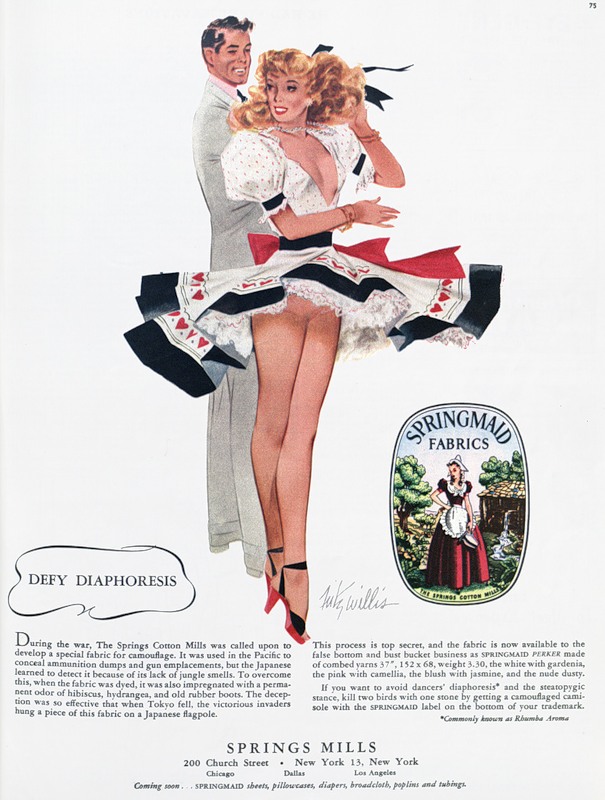World War II was, among other things, an engine for the development of new technologies. After the war, however, companies needed new markets for their products that would allow them to continue to reap profits. We’ve posted below on this effort as related to food. The 1948 ad below, for a scent-reducing and slimming camisole, is a great example of this in that the text makes it explicit (via):

Text:
During the war, The Springs Cotton Mills was called upon to develop a special fabric for camouflage. It was used in the Pacific to conceal ammunition dumps and gun emplacements, but the Japanese learned to detect it because of its lack of jungle smells. To overcome this, when the fabric was dyed, it was also impregnated with a permanent odor of hibiscus, hydrangea, and old rubber boots. The deception was so effective that when Tokyo fell, the victorious invaders hung a piece of this fabric on a Japanese flagpole.
This process is top secret, and the fabric is now available to the false bottom and bust bucket business as SPRINGMAID PERKER made of combed yarns… the white with gardenia, the pink with camelia, the blush with jasmine, and the nude dusty.
If you want to avoid dancers’ diaphoresis* and the steatopygic stance, kill two birds with one stone by getting a camouflaged camisole with the SPRINGMAID label on the bottom of your trademark.
* Commonly known as Rhumba Aroma.
And also, a quick google search shows, “ballerina bouquet” and “skater’s steam.”
—————————
Lisa Wade is a professor of sociology at Occidental College. You can follow her on Twitter and Facebook.

Comments 5
Peggy — September 25, 2009
Here's a quote from a 1948 Time Magazine article about that ad (or a similar one) which was apparently controversial at the time:
MeToo — September 25, 2009
It strikes me as being in 'bad taste' by present standards (or my standards, at least) even now. Doesn't help that the woman appears to be naked in her 'flesh tone' underclothes.
I wonder why scent-impregnated clothes never took off, though?
Cactus Wren — October 1, 2009
This was fairly standard for Elliot White Springs: his ads were almost always a bit cheerfully off-color and usually in questionable taste. One, which I'll look up and scan if I can find it and anyone's interested, showed a 1950s-stereotype "Indian maid" in deerskin tunic, arising from a hammock in which reclines an equally stereotyped "Indian brave", relaxing in what's clearly intended as post-coital exhaustion. The hammock is made out of a bedsheet: the image is captioned, "A Buck Well Spent on a Springmaid Sheet".